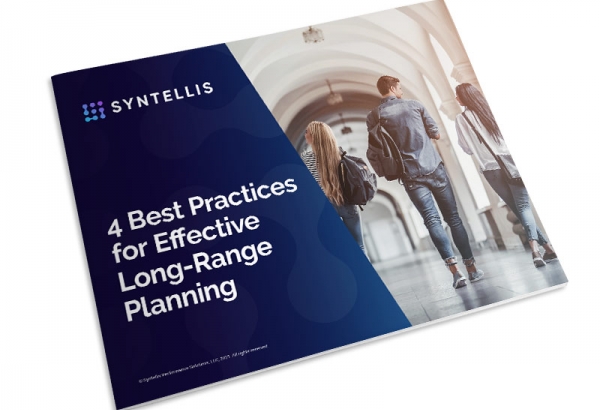Fewer than 25% of colleges and universities use enterprise performance management (EPM) solutions for forecasting or scenario modeling.1 However, the inability to reforecast or the use of cumbersome spreadsheets can leave institutions in the dark regarding how current economic forces and/or new campus initiatives affect the budget.
Scenario modeling and long-range planning tools help colleges and universities develop financial plans aligned to five- and 10-year strategic plans. Modeling also helps determine the viability of potential capital projects, academic program changes, and the potential impact of internal and external factors that can render budgets meaningless overnight.
The University of North Texas (UNT) System provides shared services for 47,000 students across three campuses. Kerry Romine, Director of Strategy and Planning, shares six efficiencies the UNT System has gained through the use of long-range planning tools.
#1 — Cohesive Financial Planning
Budgeting and forecasting are separate functions at many institutions, with little or no interplay between the two plans. Romine called the situation at UNT System “a bit disjointed” as strategic planning sessions rarely included talks about how an initiative would impact the budget for the current and subsequent years. “It was really more of a wish list,” Romine says. “Who wants a new program? Who wants a new building? It was more of an ideas session than it was a strategic planning session.”
Bringing together accounting, finance, and strategic planning processes gives the UNT System flexibility to take those wish list items and model potential impacts on the system's budget, strategic plans, and individual campuses. “With long-range planning, we can take the 100,000-foot view of what we think our campus should look like in 20 or 30 years, weighing new initiatives and infrastructure against those plans,” Romine says.
#2 — Process-Driven Review of Investments
Institutions need a mechanism to gauge the potential impacts of investments large and small on strategic plans to determine the best course of action. For example, a university has an opportunity to purchase land at a discount price, or an alum wants to donate a building for development into a new campus or specialty school. The Board of Directors wants to accept the generous offer, but does this fit into the university’s master plan?
“A lot of times what happens with large investments is it's whatever the latest greatest thing is,” Romine says. “Which is fine, as long as you have some strategic planning back behind the scenes so you can say, ‘Hey, does this fit within our strategic priorities?’”
#3 — Ability to Stress Test
A budget is only as sound as the inputs and assumptions used to develop it. As colleges and universities discovered during the onset of the pandemic, budgets can quickly become outdated. But institutions with scenario-modeling capabilities were better able to manage their way through the pandemic, modeling the impacts of the shutdown on revenues and expenses in the current semester and subsequent semesters.
Even during a “normal” budget year, finance staff can model more optimistic and more pessimistic revenue and expense projections by department, school, campus, or across the organization to help decision-makers understand the forces that can impact budget numbers.
#4 — Planning Beyond the Annual Budget
Romine stresses that long-range planning and scenario modeling are not the same as annual budgeting, calling them “the different halves of the same point.” The two processes are complementary, with budgeting data used to inform long-range plans. An integrated EPM platform allows budgeting data to flow into long-range plans, creating a much more accurate view of whatever is being modeled.
Strategic financial planning is a combination of now, near, and far, with the annual budget serving to support the near-term goals and objectives for the institution. Long-range planning informs the near and far aspects of planning, allowing institutions to coordinate near and far initiatives with the strategic plans for a particular school, campus, or the overall institution.
#5 — Focus on Long-Term Fiscal Health
A step-by-step approach to financial planning helps safeguard the long-term health of institutions by bringing deliberation and relevant data to financial discussions. The UNT System recognized a need for a more robust planning process. “We discovered we needed to create a structured, integrated, and flexible financial planning process that focuses on our long-term fiscal health," Romine says. “Then the next question is, how do we go about doing that?”
After exploring several tools, UNT System selected Axiom™ Long-Range Planning. “We decided on LRP as our system of record for our long-term financial forecast,” Romine says. “We absolutely fell in love with it, and it’s been a great implementation for us.”
#6 — What-If Analysis Guides Decision-Making
The best part of its long-range planning tool, Romine says, is the ability to guide decision-making with effective forecasting and what-if analysis that can include multiple variables.
Take, for example, a university initiative to build a new dormitory. The dorm's final size and room count can be influenced by current and projected on-campus enrollment trends, construction costs, funding sources, and many other factors. By modeling the most likely scenarios — both positive and negative — leaders can make more informed, data-driven decisions.
“There are so many intangibles involved in decision-making,” Romine says. “Axiom Long-Range Planning allows institutional leaders to make sense of those intangibles to drive informed decisions that positively impact our students.”
Get a demo to discover how Axiom Long-Range Planning provides powerful tools for financial modeling, reporting, and analytics that help colleges and universities develop mid- and long-range financial plans that are stress tested and aligned to their institution’s strategic plan.
1 2021 Higher Education Financial Technology Trends: Insights and strategies to keep your institution on track. Syntellis Performance Solutions, 2021.
Learn more about long-range planning in colleges and universities

4 Best Practices for Long-Range Strategic Financial Planning

UNT System Uses Scenario Modeling to Inform Strategic Decisions


